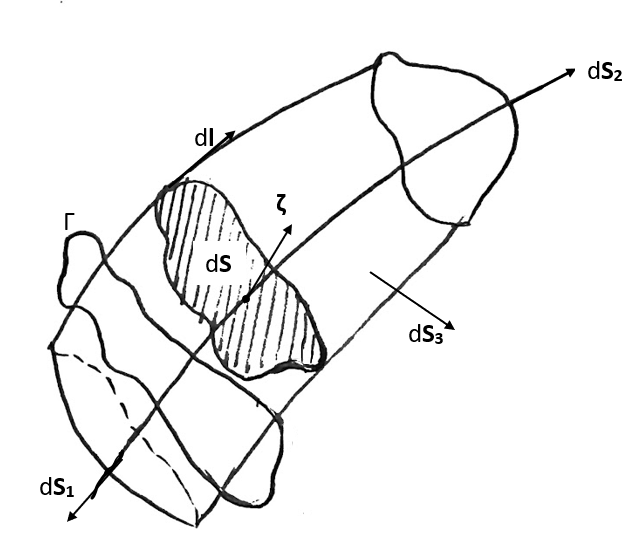Elliptical Lift Distribution
The load distribution is considered to be elliptical and is given as \[\Gamma(y) = \Gamma_{s}\left[1 - \left(\frac{y}{b/2}\right)^2\right]^{(1/2)}\]
\[\Gamma^{'}(y) = \Gamma_{s} \frac{1}{2} \left[1 - \left(\frac{y}{b/2}\right)^2\right]^{(-1/2)}\left(-2.\frac{4}{b^2}.y\right) \]
In order to find downwash and induced drag, we need to find induced angle of attack \((\alpha_{i})\) \[ \alpha_{i}(y)=\frac{1}{4 \pi U_{\infty}} \oint_{-b / 2}^{b / 2} \frac{\Gamma^{\prime}(t) d t}{y-t} \]
\[ \alpha_{i}(y)=-\frac{\Gamma_{s}}{\pi U_{\infty} b^{2}} \oint_{-b / 2}^{b / 2} \frac{t d t}{\left(1-4 t^{2} / b^{2}\right)^{1 / 2}(y-t)} \]
Substitute
\[ \begin{aligned} & t=\frac{b}{2} \cos \theta \\ & y=\frac{b}{2} \cos \theta_{0} \\ & dt=\frac{-b}{2} \sin \theta d\theta \end{aligned} \]
\[ \begin{aligned} \alpha_{i}(y) & =-\frac{\Gamma_{s}}{\pi U_{\infty} b^{2}} \oint_{\pi}^{0} \frac{\frac{b}{2} \cos \theta \cdot\left(-\frac{b}{2} \sin \theta\right) d \theta}{\left(1-\cos ^{2} \theta\right)^{1 / 2} \frac{b}{2}\left(\cos \theta_{0}-\cos \theta\right)} \\ & =-\frac{\Gamma_{s}}{2 \pi U_{\infty} b} \oint_{0}^{\pi} \frac{\cos \theta d \theta}{\cos \theta_{0}-\cos \theta} \end{aligned} \]
The solution for this integral is
\[ \oint_{0}^{\pi} \frac{\cos n \theta d \theta}{\cos \theta-\cos \theta_{0}}=\frac{\pi \sin n \theta_{0}}{\sin \theta_{0}} \]
Therefore
\[ \alpha_{i}=\frac{\Gamma_{s}}{2 U_{\infty} b} \]
\[ w=\frac{\Gamma_{s}}{2 b} \]
For an elliptic load distribution, the downwash induced by the trailing vortices is constant over the span.
\[ \begin{aligned} & L=\int_{-b / 2}^{b / 2} L^{\prime}(y) d y=\rho U_{\infty} \int_{-b / 2}^{b / 2} \Gamma(y) d y \\ & D_{i}=\int_{-b / 2}^{b / 2} D^{\prime}(y) d y=\rho \int_{-b / 2}^{b / 2} w(y) \Gamma(y) d y \end{aligned} \]
In the upcoming discussion we can prove that constant downwash minimizes the induced drag for a given lift and given span. This would result in optimum load distribution.
Let optimum load distribution be \(\Gamma^*\)(y). Then, if \(\Gamma(y)\) were changed slightly from \(\Gamma^*\)(y) without changing the lift, the change in induced drag is to be of order of square of change in \(\Gamma\).
But if nonoptimum \(\Gamma\) is slightly changed keeping lift the same, the change in induced drag is of the order of first power of \(\Gamma\)
Statement: We shall show that the elliptic load distribution \(\Gamma_{e}(y)\), say, is optimum by proving that, if load distribution is changed from \(\Gamma_{e}\) without changing the total lift, the change in induced drag is of the order of the square of the change in \(\Gamma\).
Proof: Let the change in the load distribution be \(\delta \Gamma(y)\), so that
\[ \Gamma(y)=\Gamma_{e}(y)+\delta \Gamma(y) \]
Because the altered load distribution \(\Gamma(y)\) is to produce the same lift as does the elliptic distribution \(\Gamma_{e}(y)\), we see from lift,drag equations and from above equation
\[ \int_{-b / 2}^{b / 2} \delta \Gamma(y) d y=0 \]
The downwash distribution associated with \(\Gamma(y)\) is therefore
\[ \begin{aligned} w(y) & =\frac{1}{4 \pi} \oint_{-b / 2}^{b / 2} \frac{\Gamma_{c}^{\prime}(t) d t}{y-t}+\frac{1}{4 \pi} \oint_{-b / 2}^{b / 2} \frac{\delta \Gamma^{\prime}(t) d t}{y-t} \\ & =w_{e}+\frac{1}{4 \pi} \oint_{-b / 2}^{b / 2} \frac{\delta \Gamma^{\prime}(t) d t}{y-t} \end{aligned} \]
in which \(w_{\mathrm{e}}\) is the downwash due to the elliptic distribution. Substituting above equations in drag equations, we get
\[ \begin{aligned} D_{i}= & \rho \int_{-b / 2}^{b / 2} w_{e} \Gamma_{e}(y) d y+\rho \int_{-b / 2}^{b / 2} w_{e} \delta \Gamma(y) d y \\ & +\frac{\rho}{4 \pi} \int_{-b / 2}^{b / 2} \oint_{-b / 2}^{b / 2} \frac{\Gamma_{e}(y) \delta \Gamma^{\prime}(t)}{y-t} d t d y+\frac{\rho}{4 \pi} \int_{-b / 2}^{b / 2} \oint_{-b / 2}^{b / 2} \frac{\delta \Gamma(y) \delta \Gamma^{\prime}(t)}{y-t} d t d y \end{aligned} \]
The first integral is just the induced drag of the elliptic distribution, \(D_{e}\), say. Recalling that \(w_{e}\) is constant, so that the second integral vanishes. As for the third, let
\[ f(t) \equiv \oint_{-b / 2}^{b / 2} \frac{\Gamma_{e}(y) d y}{y-t} \]
Then the third integral can be written as
\[ \frac{\rho}{4 \pi} \int_{-b / 2}^{b / 2} \delta \Gamma^{\prime}(t) f(t) d t \]
Integrating by parts \[ \left.\frac{\rho}{4 \pi} \delta \Gamma(t) f(t)\right|_{-b / 2} ^{b / 2}-\frac{\rho}{4 \pi} \int_{-b / 2}^{b / 2} \delta \Gamma(t) f^{\prime}(t) d t \]
But \(\Gamma=\Gamma_{e}=0\) at the wing tips, so \(\delta \Gamma( \pm b / 2)=0\) also, and the part integrated out vanishes. Also, from the definition of \(f(t)\),
\[ \begin{aligned} f^{\prime}(t) & =\frac{d}{d t} \oint_{-b / 2}^{b / 2} \frac{\Gamma_{e}(y) d y}{y-t} \\ & =\oint_{-b / 2}^{b / 2} \Gamma_{e}(y) \frac{\partial}{\partial t}\left(\frac{1}{y-t}\right) d y \\ & =-\oint_{-b / 2}^{b / 2} \Gamma_{e}(y) \frac{\partial}{\partial y}\left(\frac{1}{y-t}\right) d y \end{aligned} \]
Now integrating by parts with respect to \(y\), we get
\[ f^{\prime}(t)=-\left.\frac{\Gamma_{e}}{y-t}\right|_{y=-b / 2} ^{y=b / 2}+\oint_{-b / 2}^{b / 2} \frac{\Gamma_{e}^{\prime}(y) d y}{y-t} \]
Again the part integrated out vanishes
\[ f^{\prime}(t)=4 \pi U_\infin \alpha_i(y) \]
\[ f^{\prime}(t)=4 \pi w_{e} \]
Thus the third integral is
\[ -\frac{\rho}{4 \pi} \int_{-b / 2}^{b / 2} \delta \Gamma(t) 4 \pi w_{e} d t \]
Therfore the induced drag equation becomes \[ \begin{aligned} D_{i}= D_{e} + 0 -\frac{\rho}{4 \pi} \int_{-b / 2}^{b / 2} \delta \Gamma(t) 4 \pi w_{e} d t+ 0 \end{aligned} \]
\[ D_{i}=D_{e}+O(\Delta \Gamma)^{2} \]
Therefore any change in \(\Gamma\) from \(\Gamma_e\), that does not change the lift, increases the induced drag by second order in \(\Delta\Gamma\). Thus the elliptic loading is optimal, in the sense that it minimizes the induced drag for a given lift and span.
